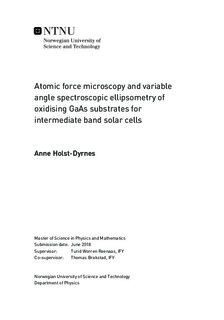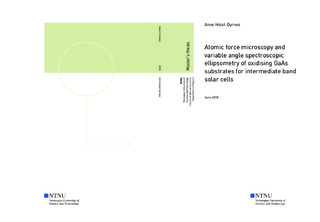| dc.description.abstract | The AFM images of the substrate sample revealed pits all over the sample surface that were tens of nanometers deep. The geometry of the pits on the surface seemed to be affected by the geometry of the AFM probe tip, indicating that the probe was unable to detect the true depth and shape of the pits, and the AFM measured surface roughness could therefore be an underestimation of the true value. The roughness varied between 1.3-2.0 nm in the 15 weeks after exposing the sample to air. Due to the large variation of the measurements, as well as unexpected drift and distortion of the images, the AFM results were deemed unreliable, and are to be considered as rough estimates. From the VASE measurements, an optical model was constructed to model the data. Ideally, the AFM resutls would have been used as input for the model to make it more accurate, but due to the uncertainty of the AFM results, they could not be used as input for the VASE model. No precise estimation of the oxide layer thickness for the substrate sample was done, but it is believed to be at least 1 nm 12 weeks after exposing the sample to air.
The AFM images of the buffer sample showed a very smooth surface, with terraces with approximately 0.28 nm average height difference between many of the neighbouring terraces. 0.28 nm is half the GaAs lattice constant, and these terraces likely stem from GaAs forming in layers of half unit cells, either during thermal desorption or during growth of the buffer layer. The surface roughness for the buffer sample was measured by AFM to around be 0.35 nm in the first few days after exposure to air. The roughness then decreased to around 0.3 nm in the following weeks. Optical profilometry measured the surface roughness to be 0.36-0.39 nm, 9 weeks after exposure to air. From the VASE measurement of the buffer sample, an optical model was constructed, combined with the AFM results an estimation of the oxide layer thickness was made. The oxide layer thickness was estimated to around be 0.8 nm after one hour of exposure to air, 1.9 nm after 2 weeks, and 2.2 nm after 4 weeks. | |

